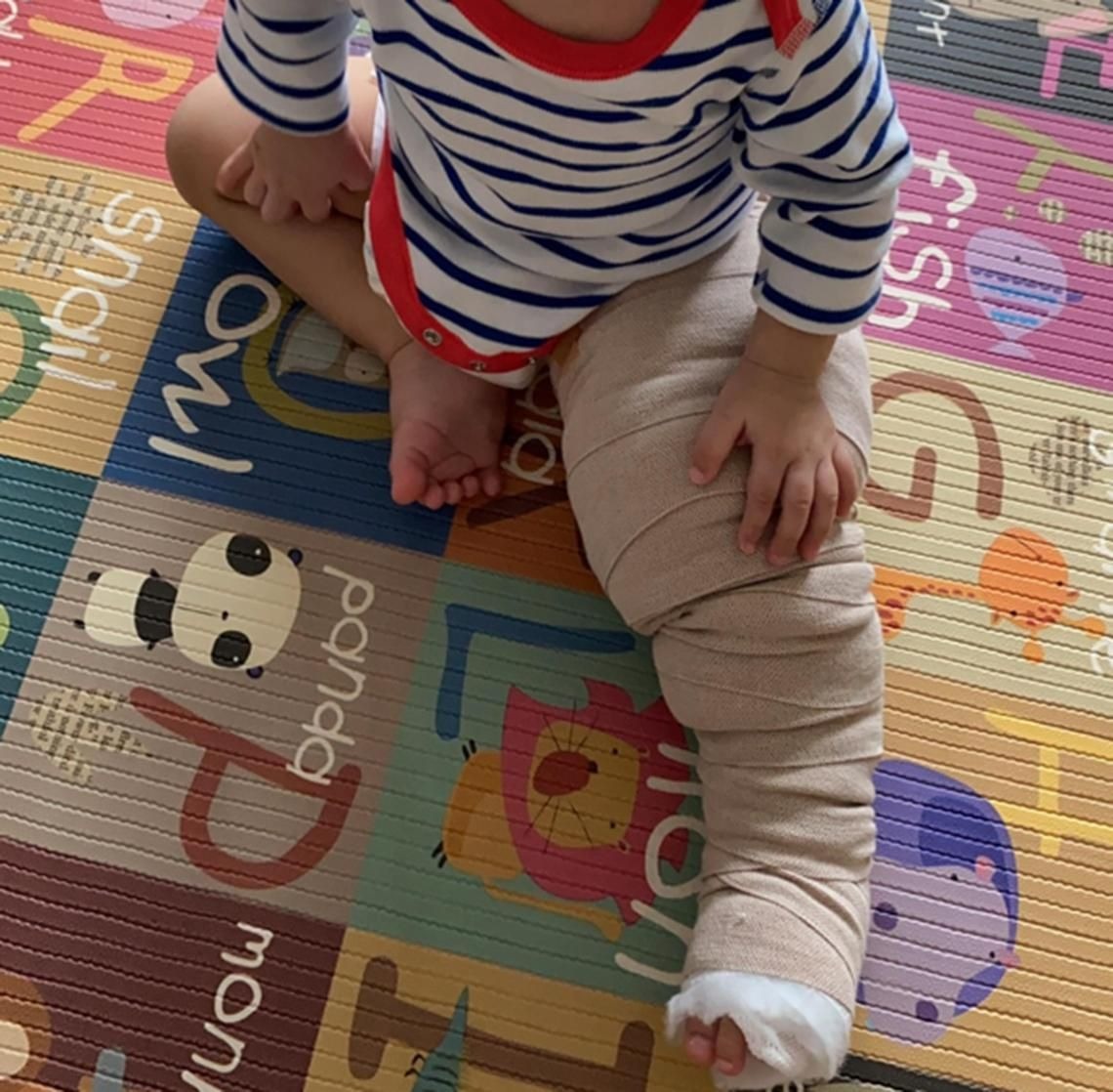Before Cassie Chow, now five, was born, it was already obvious from pregnancy scans that her left leg was much bigger than her right. PHOTO: THE RARE SKIN CONDITIONS SOCIETY (SINGAPORE) AND DEBRA (DYSTROPIC EPIDERMOLYSIS BULLOSA RESEARCH ASSOCIATION)SINGAPORE – Even before Cassie Chow was born, her mother's pregnancy scans had already shown she had an enlarged left leg.
Right after her birth, she was taken to the neonatal intensive care unit for observation due to the abnormal difference in limb size. While all her vital signs and organs were in order, she also had large port-wine stains – dark reddish birthmarks – all over her body.
"The paediatric doctor was not sure what she had," her mother Lynnette Tay, 38, told The Straits Times, but it appeared to be a rare condition.
"As with rare diseases, there is very limited awareness and management available. We had to do an MRI scan (when she was) about two weeks old. The doctors had to make multiple assumptions (and) still could not diagnose her accurately," added Ms Tay, a civil servant.
Cassie was eventually referred to Associate Professor Mark Koh, who heads the department of dermatology at KK Women's and Children's Hospital (KKH), by an oncologist from the National University Hospital where she was born.
It was not until she turned one in 2021 that she was officially diagnosed with PIK3CA-Related Overgrowth Spectrum (Pros), which is a group of conditions caused by a gene mutation that affects one in about 20,000 live births.
"We had to do biopsies to confirm that Cassie has Pros," Ms Tay said.
 Cassie at 10 months old, with her affected leg in a compression bandage to reduce swelling and pain, which increased when she started crawling. PHOTO: LYNNETTE TAY
Cassie at 10 months old, with her affected leg in a compression bandage to reduce swelling and pain, which increased when she started crawling. PHOTO: LYNNETTE TAYDr Koh told ST the condition leads to "overgrowth or malformations of various tissues, including blood vessels, lymph vessels, soft tissue, muscle and bone. This can, in turn, lead to various consequences, including pain, dysfunction, infections and abnormal blood clotting".
The mutation occurs after the early formation of the embryo in the mother's womb. It is a somatic mutation, where the change in the DNA of a body cell happens after conception. As such mutations occur spontaneously or due to environmental factors, they are not passed on to offspring.
It is also known as a mosaic mutation, because "not all cells in the body have the mutation, only the affected areas", Dr Koh said.
He said KKH sees about three to four new cases of Pros a year.
"Babies with Pros usually present at birth with abnormally enlarged, disproportionate limbs – usually the lower limbs. But it can also affect the upper limbs or, much less commonly, the trunk. There may be abnormal red to purplish stains on the skin, as well as small blebs (small blisters) that can break and bleed. The affected area may become infected, or have abnormal blood clots, leading to pain, swelling and warmth of the affected area," Dr Koh said.
He added that death due to the condition is rare, but it can occur as a result of infection or abnormal clotting, especially if such issues are not detected early.
Ms Tay and her husband Kenneth Chow, 40, read medical journals, joined local support groups for rare diseases and overseas caregiving groups, and signed up for different conferences to better understand the breadth and depth of the condition.
"I remember staying up late to attend a foreign medical conference through Zoom, because of the time difference. We were the only Asians there. Even in Singapore, Cassie had to see a multidisciplinary team of doctors. At one time, we were seeing seven different medical specialists within a span of two months," she said.
Dr Koh said Pros patients receive a combination of medical treatments, interventional treatments such as sclerotherapy for abnormal blood vessels, and even surgery to remove excess tissues. Sclerotherapy is the injection of a chemical agent into blood vessels to cause them to collapse and seal off.
Physical and occupational therapy may also be required for improvement in a patient’s daily movements through exercises, compression therapy and modalities like ultrasound or electrical stimulation.
"Pros patients can then achieve excellent results, leading to patients having normal lifespans and lifestyles," Dr Koh added.
Cassie goes to KKH every two months to have her blood tested to ensure she does not suffer any side effects from her medication.
 Cassie is now five. Her mother Lynnette Tay wants her to lead a normal life and not limit her activities. PHOTO: THE RARE SKIN CONDITIONS SOCIETY (SINGAPORE) AND DEBRA (DYSTROPIC EPIDERMOLYSIS BULLOSA RESEARCH ASSOCIATION)
Cassie is now five. Her mother Lynnette Tay wants her to lead a normal life and not limit her activities. PHOTO: THE RARE SKIN CONDITIONS SOCIETY (SINGAPORE) AND DEBRA (DYSTROPIC EPIDERMOLYSIS BULLOSA RESEARCH ASSOCIATION)Despite her condition, Cassie, now five, has a bright personality and remains a joyful little girl. She finds happiness in simple pleasures like eating gummies, and her family, including a brother who is two years older, embraces each phase of life with the hope the world will embrace her uniqueness.
"When she entered pre-school, I did up a quick knowledge guide with her photos and factual information about her condition, so that teachers would not be caught unawares while helping her to shower or changing her diapers. I asked the teachers to share the information with other class teachers, in case they took over the classes occasionally," Ms Tay said.
She expects that when Cassie goes to primary school, it "might be a lot tougher" for the girl.
"We will inform the principal and also her teachers, especially the PE teachers. While we do not want to limit her physical activities, it will also be necessary to keep her teachers informed. I guess we just have to take it in our stride and manage things as they come," she added.
To create awareness on rare skin conditions, the Rare Skin Conditions Society (Singapore) and the Dystrophic Epidermolysis Bullosa Research Association, Singapore, will be launching a book, The Skin We Wear: A Photo Story Of Skin And Kin, on May 2, 2025.
Medical Mysteries is a new series that spotlights rare diseases or unusual conditions.
Source: The Straits Times © SPH Media Limited. Reproduced with permission.
---------------------------------------------------------------------------------------------------------------------------
Source: The Straits Times © SPH Media Limited. Reproduced with permission.
